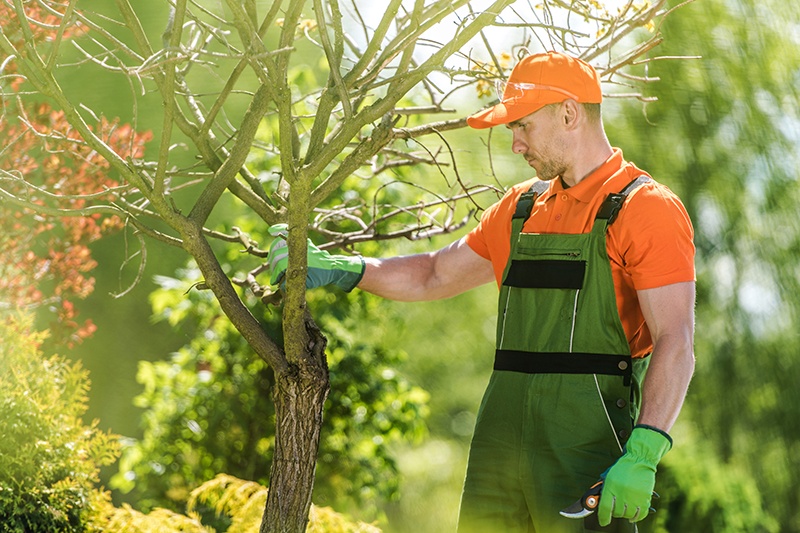Co-existing with Trees
Trees are an essential part of not only our lives, but our beautiful ecosystem we have here on Earth. They provide us with clean air, temperature regulation, and they beautify our surroundings.
However, to keep not only the trees healthy, but also the surroundings of our loved ones, proper tree care and maintenance must be prioritized.
One of those elements in managing tree care and the surrounding environment is determining which seasons are best for tree removals and tree trimmings and how to identify if a dying tree needs removal.
In this article, we’ll explore the optimal time-frames for tree removals and trimmings and at the same time while maintaining your trees’ vitality while reducing potential hazards throughout the year.
Pro Tip: Regular inspection of your trees can help identify issues before they lead to more significant problems or threats, which can lead to reduced costs and headaches in the long run.
Best Seasons for Tree Removals
There could be plentiful reasons why you might want to remove a tree such as a dead or dying tree, obstructive growth causing hazards, diseases infesting the tree’s structure, or damage caused by invasive root systems which compromise nearby infrastructure.
Let’s dive into some advantages and disadvantages of removing trees in certain seasons.
Best Season for Tree Removals: Late Winter / Early Spring (February to April)
Late winter or early spring is generally considered the best time for tree removal.
This period is when most trees are dormant and have reduced metabolic activity; thus, their stress levels are at a minimum during these months.
With the foliage gone in most deciduous trees during this season, it becomes easier for professionals to access and see potential problem areas within the branches or trunk system.
A tree removal expert team in Rochester, NY says “A tree can be removed during any season, but some trees are best if the leaves are gone, so we can see the structure of the tree and not only provide more accurate cutting, but also makes our job a lot easier.”
You can check out their tree service site if you need any kind of tree service in Rochester.
Another advantage of removing unwanted trees during late winter or early spring is that the frozen ground helps protect your lawn and surrounding landscape from unnecessary wear and tear during removal operations.
The frozen ground also helps if a branch might unexpectedly fall from the tree while removal.
Did You Know? Dormant pruning in late winter can help prevent insects from infesting fresh wounds on your tree.

Tree Removal in Other Seasons
- Summer: Tree removal during the summer months can be challenging as higher temperatures can cause additional stress on the tree, leading to a longer recovery period once removed. Furthermore, service providers may see increased demand during the summer, which could result in higher costs for tree removals.
- Fall: The falling leaves of autumn may make it difficult to accurately assess the health of a tree before removing it. Additionally, poor weather conditions (including weather in certain states) and reduced daylight hours during fall months can pose challenges for proper tree removal.
- Winter: Although we said it was the best season, in some areas of the US, extremely cold temperatures and snow can potentially damage equipment and create safety concerns for workers engaged in tree removal activities during this season.
Best Season for Tree Trimming
A well-maintained tree not only enhances your property’s appearance but also reduces potential risks presented by falling branches or imbalanced growth.
Before an expected storm, it may be wise to get your tree branches trimmed, as a branch during a storm can cause damage to property, which may incur even more costs for home and property repairs.
Why You Might Want Your Tree Trimmed
- Safety – Removing hazardous branches that pose risks to people and property.
- Health – Promoting healthy growth by removing diseased or dead limbs.
- Aesthetics – Improving the overall appearance and shape of trees within your landscape.
- Sunlight – Allow sunlight to penetrate into a building or home or more Vitamin D.
Best Season for Tree Trimming: Late Fall / Early Winter (November to early December)
Tree trimming is most effective during late fall or early winter because pruning minimizes the spread of diseases common among trees and other plants during warmer seasons.
Since this is the period at which trees enter their dormancy, trimmed areas will heal more quickly with reduced energy drain on the plant compared to active growth periods.
The absence of foliage also allows better visibility for assessing which branches require attention or removal when pruning trees during this time.
Tips for Successful Tree Trimming During Other Seasons
- Spring: Limit pruning during active growth periods, as unessential cuts may weaken the tree’s overall structure.
- Summer: If necessary, address damaged or diseased limbs, focusing on light trimming tasks rather than extensive pruning.
- Fall: Refrain from heavy pruning as this could disrupt the tree’s dormancy process and cause detrimental effects to its winter-preparation.
Consider Hiring Professionals for Tree Removal and Trimming
While many homeowners feel comfortable tackling simple tree maintenance, hiring a professional arborist (who are informed about arboriculture) or tree service is highly recommended when it comes to more complicated jobs such as tree removal or extensive trimming.
Benefits of Hiring a Professional Tree Service
- Expertise in identifying tree issues – Professional arborists can spot potential problems and address them more effectively than most untrained individuals.
- Proper techniques and equipment – Trained professionals possess the necessary tools, equipment, and knowledge to safely remove or trim trees without causing collateral damage. Not only do they have the equipment, but they also have the training to go with the specialized equipment.
- Speedy and efficient service – Tree specialists will address tree problems, quicker, faster and more efficiently than the normal person, thereby reducing longer periods of work, while also reducing noise (from equipment) and disturbance to your neighborhood.
Pro Tip: Always ask for detailed estimates before committing to any tree removal or pruning services.

Preparing Your Trees for Removal or Trimming
With proper planning your trees will receive the care they need while minimizing unintended consequences.
- Inspection: Regularly inspect your trees for noticeable signs of illness, dead branches, or any hazards that might require immediate attention.
- Communication with neighbors: If your tree borders another property, discuss any planned work with neighboring homeowners beforehand to avoid misunderstandings or disagreements about shared responsibility.
- Local Regulations: Familiarize yourself with local government regulations regarding tree care, because some trees may not actually belong to you, but to the city of your location. So make sure to consult with your local city or government first before getting a tree removed. You can also consult with tree specialists and they can check if the tree belongs to the city.
Conclusion
Proper tree care is crucial both for the health of your trees and the safety of your surroundings.
By following our tips and guidelines in our post, you can be surrounded by healthy, beautiful and of course, safe trees all year round.
Remember that the optimal season for tree removal is in late winter/early spring.
And the optimal season for tree trimming is late fall/early winter.
Also, seeking a professional tree service will not only save you time and resources but can also result in a more proactive, long-term solution for maintaining beautiful, healthy trees.






